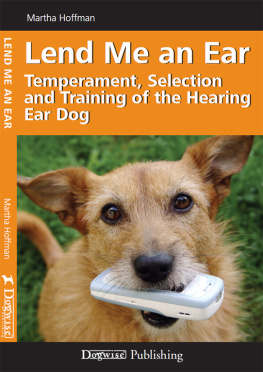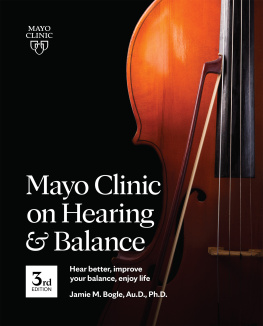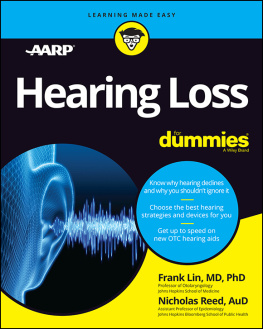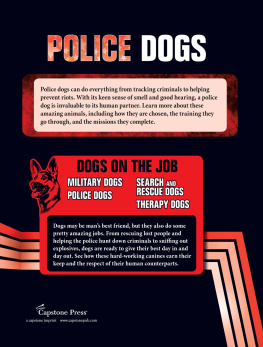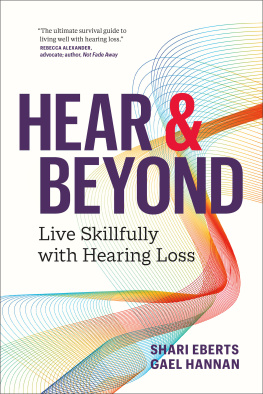
Lend Me an Ear
The Temperment, Selection, and Training of the Hearing Dog
Martha Hoffman
Dogwise Publishing
A Division of Direct Book Service, Inc.
403 South Mission Street, Wenatchee, Washington 98801
1-509-663-9115, 1-800-776-2665
www.dogwisepublishing.com / info@dogwisepublishing.com
2013 Martha Hoffman
All rights reserved. No part of this book may be reproduced or transmitted in any form or by any means, electronic, digital or mechanical, including photocopying, recording or by any information storage or retrieval system without permission in writing from the publisher.
Limits of Liability and Disclaimer of Warranty:
The author and publisher shall not be liable in the event of incidental or consequential damages in connection with, or arising out of, the furnishing, performance, or use of the instructions and suggestions contained in this book.
ISBN: 978-1-61781-121-0
Printed in the U.S.A.
Authors Note
Despite a strong demand for information regarding Hearing Dogs among trainers and people needing assistance, Lend Me an Ear went of out of print several years ago when the original publisher was acquired and the company that bought it chose to focus on books with more mass market appeal. I am very pleased that Dogwise Publishing, which specializes in more narrowly focused books on dogs, chose to reprint it and get it back into the hands of those who need it.
While the book was written years ago, the basics of selecting and training Hearing Dogs are still fundamentally the same. There have been some technological and legal advances that have changed the jobs of Hearing Dogs. Today less phone alerting is needed, but there are other new sounds to conquer when you think of all the sounds a smart phone can make when a call, text message or email is received. The recent development and increased use of Cochlear Implants (CI) by hearing impaired people means they may not need the assistance of a Hearing Ear dog during the day, but they still need a dog who can alert on sounds when the CI is turned off.
The widening impact of the Americans with Disabilities Act (ADA) has meant that the use of Hearing Ear dogs in public areas is more accepted and that has spurred interest by more hearing impaired people to use dogs to assist them. This book provides a fundamental understanding of how to select and train a Hearing Dog. Advances in temperament testing and training techniques means the odds of selecting the right dog has improved as training techniques continue to evolve, teaching the dog what he needs to know can be done even by people without extensive dog training experience.
I owe thanks to more people than I can name for encouraging me to pursue reprinting this book. But I do need to mention Cristina Carles, director of Spains Hearing Dog Program. Cristina had such faith in Lend Me an Ear that she and her colleagues translated and printed an edition in Spanish to make it accessible to so many more people. I also want to acknowledge Charlene Woodward of Dogwise Publishing for her advice and encouragement which led to bringing the book back into print and for the first time in a variety of digital formats.
The San Francisco SPCA Hearing Dog Program has been in existence since 1978. Director Ralph Dennard was recruited to start it by SPCA president Richard Avanzino, who saw something innovative and exciting in this concept. The only other program at the time, the American Humane Association Hearing Dog Program, was in Denver, Colorado. Ralph researched the Denver program and then started to build a program for adopting, training, and placing Hearing Dogs in California. Through much experimentation over the years, he, together with other trainers like Mel Robles and Becky Woodruff, developed selection and training systems.
In 1989 Kathy O Brien, Shelley Monson, and I joined the staff. Kathy has been training and breeding dogs and trailing with them since she was a child. Her extensive experience with sighthounds allowed her to train the most difficult Hearing Dog adoptees. Shelleys experience was in training and handling wolves and other wild animals; she often joked that Hearing Dogs were just another kind of wild critter. I had trained my own two dogs in AKC obedience, tracking, and tricks. We were all dog crazy and spent all our spare time at training classes, seminars, and trials. Weve had many good times over the years, and the hundreds of joyful, exuberant, and sometimes difficult and frustrating Hearing Dogs that passed through the program kept us from growing complacent about our skills.

Martha Hoffman with some San Francisco dogs. (Photo by Glassner, SF-SPCA)
Ralph, Kathy, Shelley, and I spent countless hours debating what traits made up Hearing Dog temperament and whether it even existed. If it did, what factors were important? How could we predict which dogs would succeed? Gradually, we began to sort out the mysterious qualities that interacted to produce Hearing Dog temperament. Such a blueprint, we reasoned, would help us in the selection and training of individual dogs.
This book, then, is grounded in our joint work and history. In addition to those mentioned above, I would also like to thank trainers Patricia Cook, Ivan Balabanov, and Dean Calderon. Ruth Zultner, a fellow dog enthusiast and writer, contributed conceptual editing and encouragement. Mark Anderson, my editor, showed remarkable skill at making brilliant condensations of difficult concepts. My parents, Lynn and Ted Hoffman, always made writing books seem easy when I was a child, and whenever Ive complained about how hard writing really is, they helped with organizing and editing. The most important clues were supplied by those who know Hearing Dogs best, their human partners. It was they who shared the many examples of Hearing Dog perspicacity that enliven the text.
Martha Hoffman
San Francisco, California
Compared to dogs, all humans are hearing-impaired. Over the long course of their domestication, dogs have been valued for their ability to hear sounds that humans cannot. Their ability to alert their canine or human pack members to sounds relevant to hunting or survival opportunities has been preserved or intensified in many breeds. Deaf and hard-of-hearing people have, of course, appreciated these abilities even more, and have a long history of training their own dogs. However, it is only in the last twenty years that any organized effort has been made to systematically train or breed dogs for this purpose. Because the breeding effort has been limited to attempts to create suitable strains within a few breeds, there is no new breed or mix developed specifically for use as a Hearing Dog.
Many breeds of dog possess some of the traits necessary for sound alerting work, but no single breed displays all of them consistently. In addition, many breeds that are partially suitable also show undesirable traits that negate their potential. Part of the reason that mixed breeds have proven to be so successful as Hearing Dogs is that they may accidentally inherit the optimum combination of qualities needed. Although the effects of random mixing of breeds and hybrid vigor might seem sufficient to explain why so many training programs use more mixed breeds than purebreds, there are other factors at work as well; crossing dogs from certain functional breed groups can produce individuals that seem as if they were born to become Hearing Dogs.
What is a Hearing Dog? Because most people have not yet heard of this type of assistance dog, I probably answer this question at least twice a day. Im happy to explain that its a dog that alerts its hearing impaired partner to sounds that they would want to know about. But my confident answer always amuses me, because I dont really know what a Hearing Dog is. For ten years, Ive been trying to figure this out. Every dog adds some little clue to the puzzle, and every dog also puts doubt into the new theories I come up with. But Hearing Dogs are very real and are everywhere you lookwhen you know what youre looking for!
Next page
